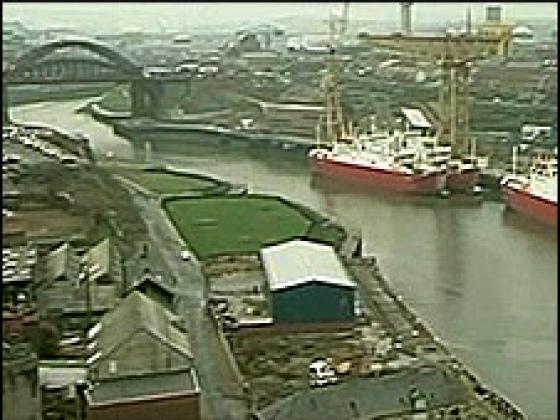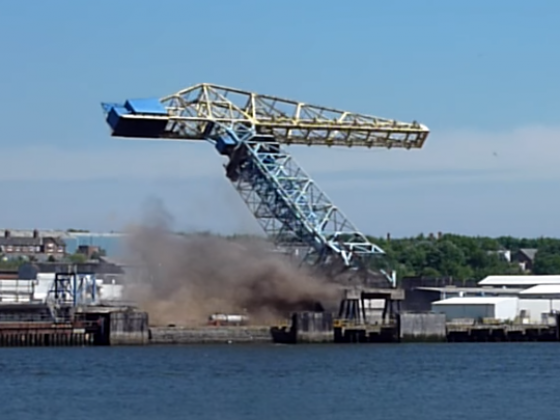Britain’s shipbuilding industry relied on British traders buying ships that were built in Britain. The break-up of the British Empire and increasing globalisation shifted this balance, and by the 1930s British shipowners were starting to look elsewhere for their ships.
After the Second World War, Britain’s market share (the percentage of ships being built in Britain) fell dramatically, and by 1964, Japan was building 50% of the world's ships, in terms of 'tonnage' (the amount of cargo ships can carry).
Overall demand for ships was high, so the shipyards were still busy, but many people realised there was a problem. In 1965, a government enquiry was established, resulting the the 1966 Shipbuilding Inquiry Committee 1965-1966 Report, also known as the Geddes Report. In response, the 1967 Shipbuilding Industry Act led to the merging of smaller firms. However, this was just one of a series of reports commissioned by all levels of government and the unions, including:
- 1975: A study of Shipbuilding in Tyne & Wear. M Hague. Commissioned by Tyne & Wear County Council.
- 1985: Shipbuilding: Public or Private? Prepared by the CSEU Joint Working Party on Privatisation, Swan Hunter Shipbuilders Ltd and North East Trade Union Studies Information Unit.
In the 1970s, the Labour Government decided to take national control of the shipbuilding industry and on 1 July 1977, some 27 companies involved in shipbuilding, marine engineering and training were nationalised.
Unfortunately the timing could not have been worse. In 1978, 75% of all the world’s shipbuilding berths were empty - the big post-WW2 slump had finally arrived.
In 1979, the Thatcher Conservative Government came to power. They did not agree with nationalised industry, and many people argue that they purposefully ran down the UK shipbuilding industry to gain support for its re-privatisation. Others suggest that the decline was inevitable, given the pressures of overseas competition from places where rates of pay were much lower and government subsidies were higher.
Ken Douglas, who held various management positions including Managing Director of Austin & Pickersgill, recalled:
“In 1983, there was an international conference in London, and all the shipbuilders were there. We talked to the President of the Korean Shipbuilders Association. We asked him why they did not quote even higher prices, because even if they did, we still would not be able to compete. He said they were not worried about us or any other European competition, or even about Japan, but they were worried about China. China now has twenty shipyards, and at the time a senior executive in a Chinese yard got the equivalent of £40 per month. The fundamental point is that shipbuilding is a labour intensive industry, and the largest element of cost is labour. If there is a large differential in the basic labour rates then there is a productivity gap which can not be closed.”
(Interview with Ken Douglas, published with permission of Professor Hugh Murphy, Series Editor, Research in Maritime History Series, Liverpool University Press)
A series of heavy redundancies made it clear the industry was in serious trouble. In 1983 and 1984 the Tyne & Wear County Council, in partnership with the unions, ran a ‘Save Our Shipyards’ campaign. It gained widespread community support, and generated discussion in the House of Parliament (for example, you can read this speech by former MP for Jarrow, Don Dixon).
Despite this, in December 1988 the Prime Minister announced that the Wear shipyards would close. Swan Hunter was by then the only shipbuilding firm left operating in the North East. They has been re-privatised in 1987.
Swan Hunter was officially designated a warship builder, and because of this they were not eligible for certain European Economic Council (EEC) subsidies to build merchant ships. The end of the Cold War led to a serious downturn in the need for warships, and in 1993 the receivers were called in. At the last minute, the famous Wallsend shipyard was saved by a Dutch millionaire, Jaap Kroese, and continued for another decade. However, in the mid 2000s, their machinery was sold to an Indian firm, Bharati Shipbuilding. The last of the giant cranes that used to dominate the river Tyne were demolished in 2010.
.560x420_crop__autoautoautoauto.JPG)
Barry Martin of Swansnappers reflects on the end of Swan Hunters
(External link)
In this short video, Barry Martin of the Swansnappers amateur photography group reflects on the importance of Swan Hunter shipyard in his local community of Wallsend.

BBC Wear - Last Wearside Shipyard is Sunk
(External link)
BBC Wear article, 'Last Wearside shipyard is sunk'

Demolition of the Swan Hunter cranes
(External link)
The demolition of the Swan Hunter cranes was caught on film by digitalgaz.

Eddie Cain of Blyth, Remembering the Closure of Blyth Shipyard
(External link)
Listen to Eddie Cain's interview about his time working in the Blyth Shipyard until its closure in the 1960s, courtesy of Port of Blyth Heritage.
Reflections from British Shipbuilding management
In the 1990s, Anthony Slaven interviewed many shipyard managers, union leaders and local MPs about their experiences. The edited interview transcripts are included in a book called Crossing the Bar: An Oral History of the British Shipbuilding, Ship Repairing and Marine Engine Building in the Age of Decline 1956-1990. We have included some quotes here, to show that there were many different attitudes, even at management level.

Swan Hunter company website
(External link)
Swan Hunter is now a specialist company in the marine engineering sector, but no longer builds ships.